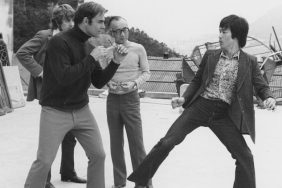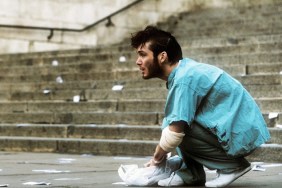When Drive came out in 2011, it became an instant critical success thanks to its blend of art house sensibilities, action and film noir aesthetics. It became a clear example of an only recently codified genre: the art house action movie. Although examples of art house action – that is, movies in which action sequences are used to punctuate a individual creative vision rather than mainstream entertainment – can be found throughout film history, it’s only recently with Drive, Hannah and a few other examples we’ll get to in a moment that the genre has received any kind of mainstream attention. Let’s take a look back at some of the best films the genre has to offer, from the present day all the way back to the 1950s, with this, The Ten Best Art House Action Movies!
10. Haywire (dir. Steven Soderbergh, 2012)

It’s too early to be anywhere other than the bottom of the list, but Steven Soderbergh – who helped redefine American independent cinema with 1989’s Sex, Lies and Videotape – busted out a great art house action film this very month with Haywire, a film that took storytelling clichés from the straight-to-video action genre and gave them fresh life by taking them completely seriously. Mixed martial arts star Gina Carano plays Mallory Kane, a black ops agent betrayed by her handlers and out to clear her good name. Plotwise, that’s literally it, but Soderbergh knows not to reinvent the wheel. Tired action sequences are told subjectively, giving the film an impressively intimate quality, and the impressive cast is given just enough to do that they make a traditionally two-dimensional genre feel lived in and real. It might not amount to much, but that’s the whole point. Even the contemptuously familiar can be seem important when filmed by a director with unique sensibilities.
9. Gloria (dir. John Cassavetes, 1980)

When you think of action movies, you probably don’t think of director John Cassavetes, whose intimate filmmaking style gave us such independent classics as Minnie and Moskowitz and A Woman Under the Influence. But there one of his art house movies married his auteur sensibilities with a grindhouse action sensibility: Gloria, starring his wife Gena Rowlands. She plays Gloria, a gangster’s girlfriend who takes in a small child whose parents are targeted by the mob. She winds up on the run with the kid, who drives her nuts. Like most great art house action movies, Gloria puts character ahead of traditional shootouts, helping to codify the laid-back gangster dialogue that Quentin Tarantino eventually popularized in films like Reservoir Dogs and Pulp Fiction. But that just makes the sudden bursts of violence all the most thrilling. None other than Dog Day Afternoon director Sidney Lumet remade Gloria in 1999 with Sharon Stone in the title role, but as you can imagine, it’s not nearly as good as the original.
8. Batman (dir. Tim Burton, 1989)

Don’t see it? Then stop and think about the history involved. The fact that Tim Burton’s original Batman was a smash hit seems unfathomable in this day and age. This is art house action filmmaking at its most outlandishly stylish, serving the director’s aesthetic whims in defiance of mainstream convention. Burton took Batman, a character who had been reinvented multiple times in the comics but by 1989 remained a figure of high camp in the mainstream (thanks to the popular 1960’s Adam West television series), and slapped him in the middle of an overt homage to silent German Expressionism. If that’s not art house, we don’t know what is. The plot is so hopelessly arch that it feels incidental, as do the characters, who fall into operatic caricatures instead of traditional Hollywood character arcs. If Batman had bombed, it would be seen today as an unsung masterpiece of audacious Hollywood creativity, but it succeeded so well that over the course of three sequels it succumbed to gross over-stylization, culminating in Joel Schumacher’s franchise-killing Las Vegas tackiness.
7. Ghost Dog: Way of the Samurai (dir. Jim Jarmusch, 1999)

Director Jim Jarmush is not who you’d expect to headline an action movie, but that’s just what he did in 1999 with Ghost Dog: Way of the Samurai, starring future Oscar-winner Forest Whitaker. As you can imagine, the director Strangers in Paradise and Dead Man didn’t follow the traditional Hollywood script when crafting his story about a hit man (Whitaker) who fights for his life when the men who hired him, covering their tracks after a hit gone right, target him for extermination. No, Jarmusch fills his films with homages to Jean-Pierre Melville’s Le Samourai and Seijin Suzuki’s quirky Branded to Kill, itself an art house action classic, giving Ghost Dog a decidedly off-kilter feel for an American film of any stripe. Filled with quiet moments of interpersonal relationships that segue, not contrast, beautifully with the action, Ghost Dog is one of the few art house action classics.
6. Django (dir. Sergio Corbucci, 1966)

Shortly after Sergio Leone reinvented the western with his Man with No Name movies, director Sergio Corbucci went completely nuts with the genre. The resulting film was Django, originally hailed as one of the most violent films ever made. More focused on style than many other art house action films, Django takes the mythic American west and infuses it with surreal, gothic imagery. Rather than introduce his hero coolly enter the ill-fated town out of the sunrise, Django (Franco Nero) trudges through the rain dragging a coffin behind him. The glory of cinematic violence is trashed as he seeks revenge for the murder of his wife, suffering horrific torture throughout the film. Though highly unusual, Django became an enormous hit in Italy, where it spawned an entire sub-genre of dreamlike westerns, many of which had the word “Django” in the title even if the character didn’t actually show up on screen.
5. Run Lola Run (dir. Tom Tykwer, 1999)

In 1999, a year dominated by excellent and surreal films like The Matrix, Fight Club and Being John Malkovich, director Tom Tykwer made a big splash with his third film, Run Lola Run. The electric and propulsive film, about a young woman (The Bourne Identity’s Franke Potente) who has only minutes to run across town, and somehow amass a small fortune along the way, to save her boyfriend’s life. Tykwer’s music video-inspired storytelling keeps the minimal story buzzing along until, surprisingly, she fails. Unsatisfied with the conclusion to her story, she says, “Stop,” and the film resets back to the start of her journey, where she tries again until she gets it right. The cartoonish world of Run Lola Run was a breath of fresh air in the foreign film market, and although Tykwer hasn’t made as impressive a film since (although The International is very underrated), this art house action favorite remains a strikingly impressive piece of filmmaking over ten years later. There’s still nothing else like it.
4. El Mariachi (dir. Robert Rodriguez, 1992)

Although most Robert Rodriguez fans were probably introduced to the director via the sequel, Desperado, his first film El Mariachi remains as vibrant a cinematic debut as any you’re likely to find. Produced on a barebones budget, Rodriguez used money he made from donating his body for medical experiments to finance the feature for $7,000 (a figure which eventually spiked dramatically in post-production), and although it packs a punch equaled by many mainstream action efforts, El Mariachi still retains its art house roots. Rodriguez took a figure minor stature in the Mexican culture, the traveling musician, and through a series of unexpected circumstances turned him into an action icon for the modern age. Subversive, dramatic storytelling and impressive action sequences make up for the film’s many rough edges. He was clearly a filmmaker on the rise, and is now one of the faces of modern grindhouse filmmaking.
3. The Killer (dir. John Woo, 1989)

John Woo finally broke out in the United States with The Killer, a dramatic action spectacle based on tragedy and melodrama as opposed to the then-typical masculine superman schtick of the 1980s. Chow Yun-Fat stars as an assassin who accidentally blinds a helpless lounge singer in a shoot out, and now takes jobs to pay for the surgery necessary to save her sight. The slow-mo action sequences would become so popular that they turned into a cliché, but the dramatic punch from the hero’s doomed romance with his own victim, and his respectful relationship with the cop (Danny Lee) tasked with taking him down elevated The Killer from a standard action thriller to a work of art rarely paralleled in the genre. Woo had made great dramatic action films before (A Better Tomorrow) and since (Bullet in the Head), but The Killer remains his masterpiece, and helped turn Hong Kong action into a stateside phenomenon in the 1990s.
2. Léon: The Professional (dir. Luc Besson, 1994)

French director Luc Besson is practically a household name in the action community these days, now that he spends most of his time producing hits like Taken, theTransporter movies and District B13. But he started by directing art house action films of his very own, like the post-apocalyptic Le Dernier Combat and the influential La Femme Nikita. His best art house action movie, however, is easily Léon: The Professional, released in a heavily cut form in the United States as merely The Professional. Jean Reno stars as a introverted hit man who, like Gloria before him, finds himself caring for a young kid after their family is murdered by criminals. This time it’s the adolescent Natalie Portman, in her cinematic debut, and this time she falls in love with him. Their relationship never quite spirals into Lolita territory, but the superior foreign version of the film dwells on their unusual dynamic to a dramatically satisfying (and intentionally disturbing) degree as he trains her to become a young assassin. Natalie Portman became an instant star, Reno has never had a better role and Gary Oldman practically explodes in every scene as the corrupt cop responsible for the mayhem. But at its heart, Léon: The Professional is a character study, pure and simple, no matter how many bullets go flying.
1. Seven Samurai (dir. Akira Kurosawa, 1954)

Akira Kurosawa’s samurai films are, perhaps, the original art house action movies. It was Seven Samurai that made American audiences realize foreign films could be just as action-packed as their domestic counterparts, and the action genre would never be the same. Literally. Many of the tropes we now take for granted can be traced back to Seven Samurai, and were all daringly artistic for their time. Cutting back and forth between slow-motion and 24 frames per second? That’s Seven Samurai. Stories about a group of badasses uniting for a specific action-oriented mission? That was also Seven Samurai. Full of action spectacle without ever sacrificing character or story, Kurosawa’s tale about a group of samurai (seven of them) hired to protect an impoverished town from hostile invaders was so unexpected that Hollywood was forced to react, remaking the film with an all-star American cast in 1960’s excellent western The Magnificent Seven. Kurosawa went on to other samurai classics like The Hidden Fortress, Yojimbo (unofficially remade as A Fistful of Dollars by Sergio Leone) and its underappreciated sequel, Sanjuro.








